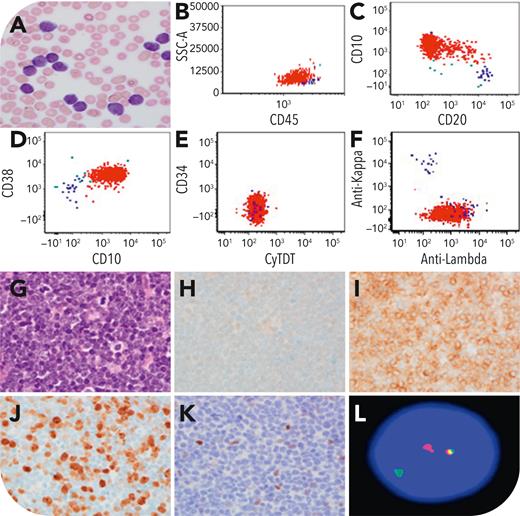An 8-month-old boy presented with scalp nodules and diffuse lymphadenopathy. Complete blood cell count showed leukocytosis (white blood cell count, 282 000/μL), anemia, and thrombocytopenia. Peripheral blood smear (panel A; Wright-Giemsa stain, 100× objective) showed numerous medium-sized lymphoid cells with blastic morphology. Flow cytometry (panels B-F) detected surface λ light chain restricted B cells expressing CD19, CD20 (partial), CD10, and CD38; the cells were negative for CD34 and terminal deoxynucleotidyltransferase (TdT). Biopsy of the left inguinal lymph node (panel G; hematoxylin and eosin stain, 100× objective) showed sheets of monotonous medium-sized cells with multiple small nucleoli and frequent mitoses. The cells were B-cell lymphoma (BCL)6− (panel H; 100× objective), BCL2+ (panel I; 100× objective), Ki-67 60% (panel J; 100× objective), and c-MYC− (panel K; 100× objective). Fluorescence in situ hybridization was positive for KMT2A rearrangement (panel L) and negative for MYC and BCL2 gene rearrangements. Molecular studies detected the KMT2A::MLLT3 fusion and 8-bp deletion of KMT2D gene, leading to a truncated loss-of-function protein. A diagnosis of B-lymphoblastic leukemia/lymphoma (B-ALL) was made.
B-ALLs with light-chain restriction or lacking both CD34 and TdT were each sporadically reported. However, cases with a combination of these 2 “mature” features are extremely rare and difficult to be distinguished from mature B-cell neoplasms. Recognition of these unusual characteristics in B-ALL should facilitate prompt confirmatory/genetic testing and avoid misdiagnosis as mature B-cell lymphoma.
For additional images, visit the ASH Image Bank, a reference and teaching tool that is continually updated with new atlas and case study images. For more information, visit https://imagebank.hematology.org.


